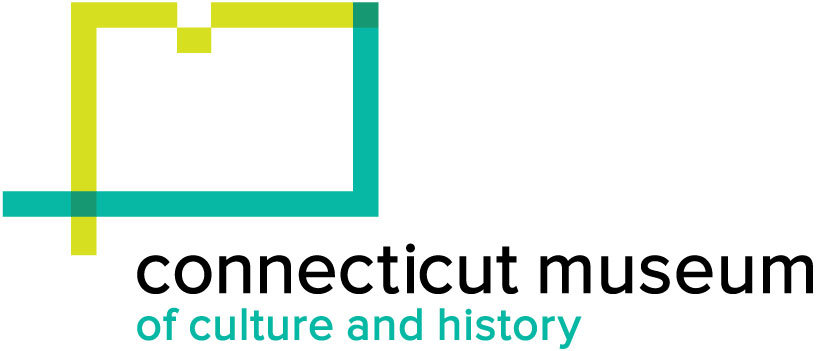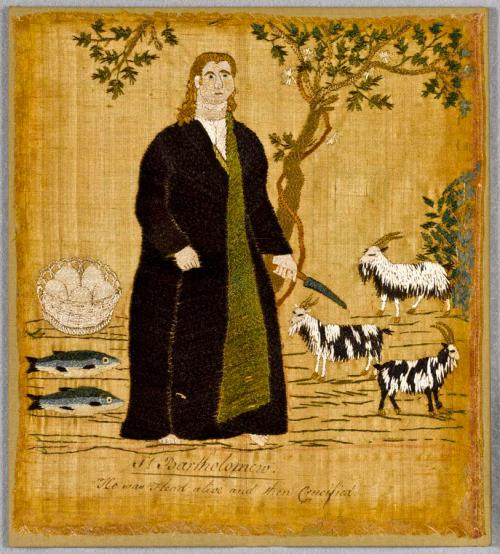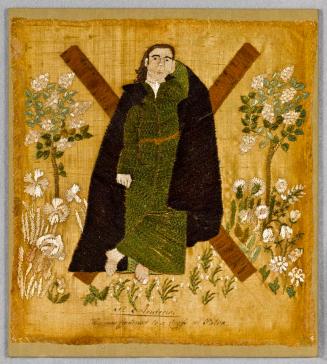St. Bartholomew.
EmbroidererAttributed to
Prudence Punderson
(American, 1758 - 1784)
Date1776-1780
MediumEmbroidery; silk thread, floss and ink on a plain-woven silk ground
DimensionsPrimary Dimensions (height x width of ground): 9 1/4 x 8 1/4in. (23.5 x 21cm)
Mount (height x width): 9 1/2 x 8 1/2in. (24.1 x 21.6cm)
ClassificationsTextiles
Credit LineGift of Newton C. Brainard
Object number1962.28.3f
DescriptionNeedlework picture worked in black, brown, green, black, white, light and dark blue, pink, red, yellow, and white silk threads on a plain-woven gold silk ground, using a surface satin stitch and other stitches. At the bottom is a hand-written inscription in black ink: "St. Bartholomew./ He was Flea'd alive and then Crucified." This is one of a group of twelve silk needlework pictures; each depicts an apostle and has an ink inscription at the bottom with the name of the apostle and a description of their death.
The needlework picture is rectangular, oriented vertically. It shows a man standing beneath a tree, holding a knife in his left hand. The man wears a long black robe, or banyan, and has bare feet. To his left is a basket filled with five loaves of bread and two blue and white fish lying on the ground . To the right are three goats.
The selvedge is located at the right edge of the needlework picture. All four edges of the needlework are whip-stitched. The picture is hand-drawn with red ink and embroidered in untwisted silk thread, floss, and a small amount of twisted yarn (two Z-spun yarns, S-plied). The ground has 112 yarns per inch in the warp and 80 yarns per inch in the weft.
Stitches: The principal stitch is the surface satin stitch; it also includes satin, stem and some free-form stitches.
Condition: There are some losses to the ground at the lower right edge and along the bottom edge. Putty, or a nother substance, has adhered to some of the embroidery along the right edge. There is some fading to the ground and embroidery. The needlework picture has been cleaned gently then stitched to a plain-woven cotton support fabric applied to a rigid mount. The picture is not framed.
The needlework picture is rectangular, oriented vertically. It shows a man standing beneath a tree, holding a knife in his left hand. The man wears a long black robe, or banyan, and has bare feet. To his left is a basket filled with five loaves of bread and two blue and white fish lying on the ground . To the right are three goats.
The selvedge is located at the right edge of the needlework picture. All four edges of the needlework are whip-stitched. The picture is hand-drawn with red ink and embroidered in untwisted silk thread, floss, and a small amount of twisted yarn (two Z-spun yarns, S-plied). The ground has 112 yarns per inch in the warp and 80 yarns per inch in the weft.
Stitches: The principal stitch is the surface satin stitch; it also includes satin, stem and some free-form stitches.
Condition: There are some losses to the ground at the lower right edge and along the bottom edge. Putty, or a nother substance, has adhered to some of the embroidery along the right edge. There is some fading to the ground and embroidery. The needlework picture has been cleaned gently then stitched to a plain-woven cotton support fabric applied to a rigid mount. The picture is not framed.
Label TextThe subject matter of this series is unique in early American needlework.
Each picture depicts one of the twelve Christian apostles, accompanied
by one or more of his traditional symbols and a caption describing
his manner of death. These grim captions contrast starkly with the
pleasant landscapes, bright flowers, and engaging animals that evoke
a Garden of Eden. The subject matter likely relates to the Punderson
family’s adherence to the Church of England, an unpopular choice in
overwhelmingly Congregational colonial Connecticut.
The stitches are executed with great precision and ingenuity on fine silk,
and convey muscles, drapery, feathers, wood grain, and wool. The facial
expressions are more individualized than was generally attempted or
achieved in early American embroidery.
NotesSubject Note: Bartholomew is listed in Matthew 10:2-4 as one of the twelve apostles. Bartholomew's death is described in John Foxe's Book of Martyrs (written and published about 1560): "Bartholomew. Preached in several countries, and having translated the Gospel of Matthew into the language of India, he propagated it in that country. He was at length cruelly beaten and then crucified by the impatient idolaters." Religious imagery often depicts Bartholomew with the knife with which he was flayed. A basket of five loaves of bread and two fish represent the feeding of the five thousand, when Christ took a basket of bread and two fishes and fed five thousand people who had come to hear him speak (see John 6:1-13). (Source: James Hall, Dictionary of Subjects & Symbols in Art)Each picture depicts one of the twelve Christian apostles, accompanied
by one or more of his traditional symbols and a caption describing
his manner of death. These grim captions contrast starkly with the
pleasant landscapes, bright flowers, and engaging animals that evoke
a Garden of Eden. The subject matter likely relates to the Punderson
family’s adherence to the Church of England, an unpopular choice in
overwhelmingly Congregational colonial Connecticut.
The stitches are executed with great precision and ingenuity on fine silk,
and convey muscles, drapery, feathers, wood grain, and wool. The facial
expressions are more individualized than was generally attempted or
achieved in early American embroidery.
Source Note: Some elements of the needlework pictures of the Twelve Apostles (1962.28.3a-l) are taken from The Artist's Vade Mecum (published in London, 1776).
Status
Not on view












